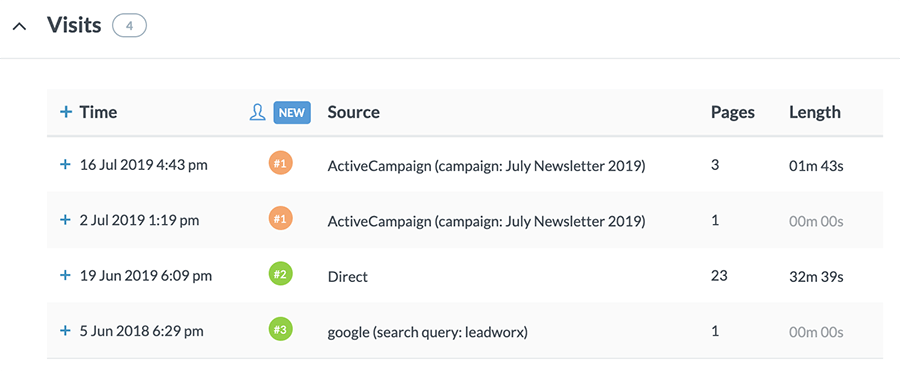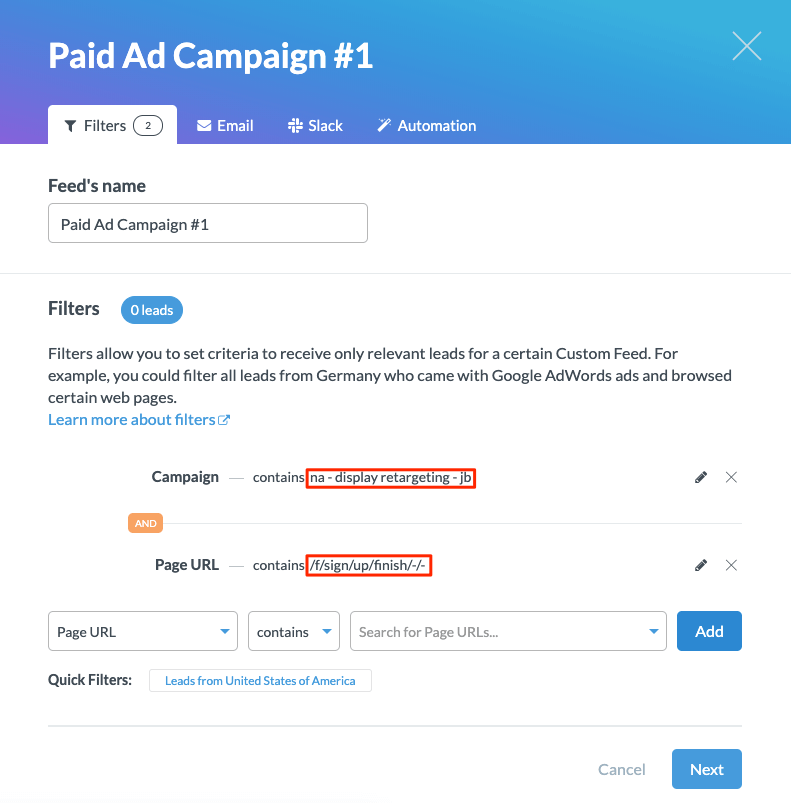Most of the content you’ll find on tracking marketing campaigns focuses on one thing: end conversions. That’s, in part, because those are the conversions most of the default reports readily accessible in Google Analytics measure.
But tracking campaigns by that approach leads to incomplete data at best. That’s because:
Not all marketing campaigns drive end conversions or have notable conversion rates
You can’t track all the little steps that add up (hopefully) to the ultimate conversion
A “conversion” means different things to different companies
You can’t connect conversions or any other website activity to the companies behind them
That’s why it’s important to tailor your campaign tracking to your customers, the buyer’s journey they walk, and the type of campaign you’re measuring. Marketers can do that by building a spreadsheet or creating custom goals and dimensions in Google Analytics—but most don’t because, well, that takes time and effort.
At Leadfeeder, that complexity and time investment is one of the things we set out to fix with our website visitor identification software. The problems above are a big deal for B2B marketing teams, and we saw how difficult they are to solve by using Google Analytics alone.
That’s why we built our tool to help add context (in the form of company names and details and behavioral data) to your B2B marketing efforts—along with simplifying the process of customizing your campaign tracking to represent what conversions looks like for your business.
In this article, we talk more about how Leadfeeder solves some of the big problems we see with tracking marketing campaigns. We also cover how to track 3 common types of marketing campaigns with Leadfeeder:
Editor’s note: Want a campaign tracking tool that’s built for B2B? Sign up and try Leadfeeder free for 14 days to view company names, details, and behavioral data for every website visit your marketing campaigns drive.
How Visitor Identification Makes Tracking Marketing Campaigns Better
Regardless of the type of marketing campaign, tracking campaign performance with a tool like Google Analytics means missing out on some important information—particularly for B2B marketers.
Based on the 30k marketing teams we’ve worked with, we wanted to build a tool that could offer more relevant and complete data to B2B marketers, without adding additional time and effort to the campaign tracking process. For that reason:
Leadfeeder helps B2B marketers put a face to all the numbers
Our tool helps track all the activity that happens both before and after the conversion
Leadfeeder Custom Feeds let you define what a conversion looks like
Let’s talk about how those capabilities can make your marketing campaign tracking easier and more valuable.
Putting a Face to the Numbers
First, we wanted our tool to help B2B marketers in particular bridge the gap between the numbers in Google Analytics and the actual accounts they target.
That’s why, when you track marketing campaigns in Leadfeeder, you don’t just see conversions—you see the actual companies behind those conversions. That includes company details like: size, industry, and more.

It also includes in-depth data on how that company (and the employees who work there) have behaved on, and interacted with, your website and other marketing campaigns.

That means you can track more than just the campaign that led to a conversion. You can see all the marketing touchpoints that led up to that conversion, and all the touchpoints that take that lead from one conversion event (like subscribing to your email list) to another (like signing up for a free trial).
For example, if IBM is among your target accounts and they visit your website, you can see exactly which marketing campaign sent that specific company to your website.
In the screenshot above, you can see that the company’s first visit to your site came from a Google search for a competing company. You can also see how many marketing campaigns (in this case, two—email marketing and paid search) have spurred the company to visit, how many employees from within the company have been to your website, and which specific pages and features they’ve shown interest in.
Tracking What Happens Before and After the Conversion
Since a marketing campaign “conversion” isn’t always the ultimate, customer-making conversion, we built our tool to help track all of those smaller conversions that lead up to the big one. After all, tracking marketing campaigns is as much about tracking what happens before and after the conversion as it is about the conversion itself—it’s about tracking the whole customer journey and every little conversion that happens along the way.
And that data shouldn’t be siloed away in Google Analytics. That’s why we built integrations with top CRM systems (including Pipedrive, Salesforce, HubSpot, and more) into our visitor identification software.

When you connect Leadfeeder with your CRM, you can see upcoming and past activity, plus any deals in the works, for any company who visits your website as a result of a given marketing campaign.
Editor’s note: Ready to turn your marketing campaigns into actionable leads? Try Leadfeeder free for 14 days to get access to the data B2B marketers need to better gauge the success of marketing campaigns.
Tracking Marketing Campaigns in Leadfeeder
Now that we’re on the same page about why you should include Leadfeeder in your campaign tracking process, let’s look at how tracking marketing campaigns with Leadfeeder works in practice. To track any marketing campaign, you have to map out 2 things that often go hand-in-hand:
How the campaign should move people through the buyer’s journey
What success metrics you’ll use to measure the campaign
Depending on where a given marketing campaign fits into and moves people through the buyer’s journey, you’ll gauge success differently.
For example, key benchmarks for a paid ad campaign might include total click-throughs, leads produced, and signups from PPC. Those metrics are essentially the steps you want people who see your paid ads to take, along the path to becoming a customer.
Each of those, then, is a type of conversion you want to be able to measure. When you track each step as a conversion, you can more easily spot any anomalies and anywhere along the way that the journey breaks down. You can also better gauge the monetary value of your campaigns.
Once you’ve set up paid ad campaign tracking in Leadfeeder, you’ll see a list of companies who’ve come from the given campaign and converted (you’ll choose how to define that “conversion”).

By clicking on any of the listed companies, you can dig into more data including company size, key contacts within the company, behavioral details on their web visit, and deal and activity info pulled from your CRM.

By contrast, if you were tracking this campaign with Google Analytics alone, all you’d see is how many website visits it drove—and you’d be missing out on the vital context that drives B2B marketing.
How to Track Paid Ad Campaigns in Leadfeeder
From the Leadfeeder dashboard, click on the blue ’+ Create new feed’ button.

Give the new feed a name and begin selecting your custom filters. In the example screenshot below, we’re tracking new signups from the paid campaign called “na - display retargeting - jb.” We’re filtering website visits that originated from that campaign and made it to the end of the signup flow. You can also by adding a source/medium filter and choosing the UTM landing page from the dropdown list.

Once you’ve added your filters, click ‘Next’ to set up email and/or Slack notifications and add any automation flows. Then click the blue ‘Save feed’ button.
How to Track Content and Organic Campaigns in Leadfeeder
From the Leadfeeder dashboard, click on the blue ’+ Create new feed’ button.

Give the new feed a name and begin selecting your custom filters. In the example screenshot below, we’re tracking new email subscribers from the blog. We’re filtering website visits that started out on the blog and subscribed to our email list.

Once you’ve added your filters, click ‘Next’ to set up email and/or Slack notifications and add any automation flows. Then click the blue ‘Save feed’ button.
How to Track Social Media and Brand Marketing Campaigns in Leadfeeder
From the Leadfeeder dashboard, click on the blue ’+ Create new feed’ button.

Give the new feed a name and begin selecting your custom filters. In the example screenshot below, we’re tracking potential that came from LinkedIn. We’re filtering website visits that originated from LinkedIn, navigated to the pricing page, and spent at least 3 minutes there.

Once you’ve added your filters, click ‘Next’ to set up email and/or Slack notifications and add any automation flows. Then click the blue ‘Save feed’ button.
Get More Information From Tracking Your Marketing Campaigns
Google Analytics is often the default when it comes to tracking digital marketing campaigns—but that doesn’t mean it’s the best (or only) option. When you add visitor identification data into your tracking, you end up with much more useful and complete data to judge your marketing campaigns on.
Get more from your web analytics.
t’s time to turn your website traffic data into something more meaningful. Website visitor analytics enable you to identify and qualify the companies visiting your website, even when they don’t fill out a form.
Show me how




